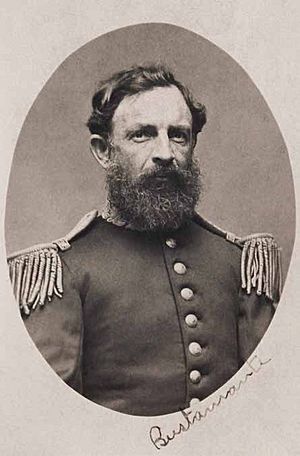Pedro Bustamante facts for kids
Quick facts for kids
Pedro Bustamante
|
|
|---|---|
 |
|
| Born | January 25, 1825 Arequipa, Department of Arequipa, Peru |
| Died | July 16, 1885 (aged 60) Santa Rosa de Ocopa, Junín, Peru |
| Allegiance | |
| Branch | |
| Years of service | 1839 – 1885 |
| Rank | |
| Battles/wars | Peruvian-Bolivian War
Peruvian Civil War of 1856–1858
Peruvian Civil War of 1884–1885
|
Pedro Bustamante y García was a brave Peruvian general. He was a Brigadier General during the important War of the Pacific. He also worked as the Minister of War and Navy for many years. He was famous for leading the fight during the Siege of Arequipa. There, his forces won against General Manuel Ignacio de Vivanco.
Contents
Pedro Bustamante's Early Military Career
Pedro Bustamante was born in 1825. His parents were Pascual Bustamante Jiménez and María Josefa García Bustamante. When he was just a teenager in 1839, Pedro joined the Peruvian Army. He started as a cadet, which is like a student soldier.
Pedro took part in the Peruvian-Bolivian War. During the Battle of Ingavi in 1841, he was captured. He was released later that year thanks to Colonel Manuel Ignacio de Vivanco. After his release, he moved to Tacna. By 1850, he had worked his way up and was promoted to lieutenant colonel.
In 1852, Pedro was sent to Cuzco. There, he worked as a military judge. The next year, he went back to Tacna. He was a commander near the border with Bolivia. This was a tense time, as another war between Peru and Bolivia almost started.
In 1854, Bustamante joined a big movement. General Ramón Castilla led this movement in Arequipa. They were fighting against the government of General José Rufino Echenique. During this time, Pedro was promoted to colonel. He was also made the commanding general of Tacna. After Castilla's group won, Pedro continued to support him. He helped Castilla against a new challenge from General Manuel Ignacio de Vivanco. This led to the Peruvian Civil War of 1856–1858. Pedro did very well during the Siege of Arequipa. His great performance earned him a promotion to brigadier general.
Chincha Islands War and Political Roles
After his military successes, Pedro Bustamante took on political roles. In 1858, he became the prefect of Moquegua. A prefect is like a governor of a region. In 1860, he became the prefect of Arequipa.
Later, he moved to Lima, the capital city. There, he worked on various government tasks. In 1865, he joined another important movement. Colonel Mariano Ignacio Prado led this national revolution. They were upset because a Spanish fleet was causing problems near Peru's coast. This event was part of the Chincha Islands War.
Pedro was sent to Chile to get weapons for Peru. When he returned, he was made the Inspector General of the Army. He fought in the Battle of Callao on May 2, 1866. During this battle, José Gálvez Egúsquiza sadly died. Pedro took over his role as the Secretary or Minister of War. He held this important position from 1866 to 1867. He continued as Minister of War under President Manuel Pardo. He also served during Mariano Ignacio Prado's second time as president. Pedro helped stop attempts by Nicolás de Piérola to take over the government. By 1874, he became the first mayor of the Barranco District.
War of the Pacific and His Final Battle
When the War of the Pacific began in 1879, Pedro Bustamante was ready to serve. He was made the commanding general of the First Reserve Division. In 1880, he became the commanding general of the Southern Division. He led one of the army divisions during the Battle of San Francisco. After that battle, he moved his troops to Arica. He also fought bravely in the Battle of Tarapacá, leading a division there too.
After spending some time in Lima, he went to Arequipa. He stayed there until the Treaty of Ancón was signed. This treaty officially ended the War of the Pacific.
Once the Chilean forces left Peru, Pedro met with General Andrés Avelino Cáceres. This meeting happened in Huancayo. Pedro offered his support to Cáceres. Cáceres was fighting against the government of General Miguel Iglesias. This conflict was known as the Peruvian Civil War of 1884–1885. Pedro Bustamante took part in the Battle of Masma on July 4, 1885. He was badly wounded in this battle. Before he died from his injuries on July 16, 1885, he was named the general commander of the constitutional army.
Pedro Bustamante's Legacy
Today, there is a square named after Pedro Bustamante. You can find it in the District of Barranco, right behind the Colegio San Luis school.
See also
 In Spanish: Pedro Bustamante para niños
In Spanish: Pedro Bustamante para niños

